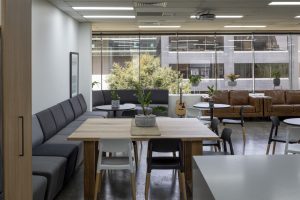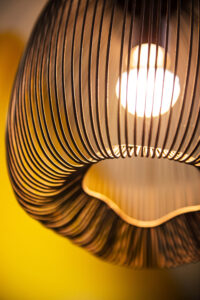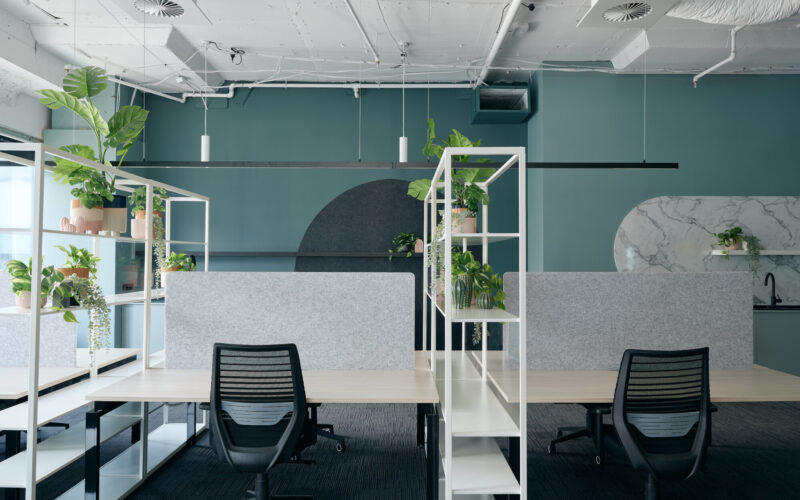The pandemic age has forced us towards a more dynamic, hybrid working environment, we must ask ourselves, how do office spaces affect productivity?
It is no secret that our physical surroundings have a large impact on how we feel, think and work. Whether at home or the office, our physical environment can either substantially diminish our ability to work effectively or elevate us to create our best work.
But what role do office fitouts, refurbishments and setups play on employee and business productivity? And more importantly, what can you do to ensure that you make the most of your office space?
The Role of Office Spaces in Productivity
Next to staff costs, office rent or mortgage is the second-highest business expense on average. So to fully understand how offices can ensure they are using their real estate budget effectively, we must first understand the role that spaces play on employee and office productivity.
Most employees spend more time in the office than with their family and loved ones. The sheer amount of time employees spend in the office shows how important it is for workers to feel happy, satisfied and comfortable in their working environment. In fact, increased employee happiness has been linked to increased productivity, talent retention and positive office culture.
Social Capital & Employee Satisfaction

One factor that contributes to increased employee happiness, satisfaction, and office productivity is the concept of social capital.
Social capital refers to the relationships and networks of employees within a workplace, which enables employees to feel socially connected to their co-workers, managers and workplace.
In other words, social capital is a fundamental aspect for employees to feel a sense of place and connection to their workplace. Naturally, having a well-designed office space and fitout adds to businesses’ social capital, increasing employee satisfaction and productivity
Office Design Effect on Productivity
But what about office design? How does this come into the equation of office productivity? Think of it like this; how easily could you go to sleep with all the lights on and loud music playing? Probably not easily.
The same principle applies to office fitouts and design. We must create commercial environments, offices and workspaces that support employees to remain as productive as possible. As the saying goes, work smarter, not harder.
Office Design & Layout
An often overlooked aspect within office design that we must consider is layout and proximity.
What do we mean by this? It’s no secret that open-plan office spaces are a contentious subject; some love them, others don’t. But one advantage of an open plan layout within commercial office spaces is that teams can collaborate easier and communicate better, which is the cornerstone of innovation.
Similarly, open plan office design provides a level of agility and adaptability that is needed in the age of COVID. Open plan provides a level of flexibility as your business and employees grow, adapt and change.

Workspaces can be adapted for different working styles, uses and numbers of employees. Providing much-needed flexibility for employees to adjust how they work, allowing them to play to their strengths, and most importantly, making sure office spaces remain as productive as possible.
Another benefit of open-plan office spaces is versatility for leaders and managers to move around, ensuring that they can be in proximity to relevant teams. New employee starting this week? Have their team leader sit close by for support, training and inspiration.
Productive Technology
Just as the design and layout of commercial office spaces grant an edge over traditional office spaces, the technology provided within workplaces provides a massive edge in terms of office productivity. But this is not limited to conventional office and commercial spaces, it also extends to hybrid working spaces, including those who work from home.
Having the right tech set-up can help with communication across teams, which in turn increases office productivity. The Society for Human Resource Management found that miscommunication costs smaller companies with 100 employees or less an average of over $585,000AUD per year.
Factors Affecting Office Productivity
Now that we have a better understanding of how spaces, design and fitouts can affect office productivity in the workplace, you might be asking yourself, what does that look like? What aspects of design and fitout affect office productivity?
Temperature & Performance
Temperature has been proven time and time again to have a profound effect on office productivity across a range of office sizes, shapes and layouts.
Why? Essentially temperature is linked to what is known as comfort factors; as comfort factors decrease, so does office productivity.

As employees experience some form of temperature discomfort, whether too hot or too cold, it becomes harder for them to concentrate on their tasks. Multiple studies back this up, stating that for each degree over 25C, office productivity decreased by 2%.
Similar studies have shown that a cold office environment can increase employees’ hourly labour costs by 10%, further highlighting the importance of the right temperature on your office’s productivity. All in all, the right temperature in the office can lead to a 5 – 15% increase in office productivity.
How Lighting Affects Productivity
Historically many businesses and office spaces have opted for fluorescent lighting for its cost-effective beam, but what was overlooked is its effect on mental stress and eye strain.

There is a large variety of choices when it comes to light: warmer light, which emits a reddish colour, is perfect for creating a sense of comfort; middle light, which is comparable to sunset or daylight which creates a welcoming tone while still promoting some alertness; and cold light, which is arguably the besting office lighting as
it improves attention, mood and office productivity while also reducing melatonin in the brain – which is the chemical that puts us to sleep.
For the best lighting to boost office productivity, office spaces should use a mix of the three lighting categories.
Productivity in the Air
We often take fresh air for granted. How many times a day have you taken a deep breath, and appreciated the cleanliness, quality and freshness of the air?
It may seem like a bit of a no brainer, but good quality air and airflow are like oil for an engine; it keeps everything running smoothly and working together. Particularly during the COVID age, it is fundamental to ensure that your office or commercial space has adequate airflow to reduce the risk of office-wide infections.
Even outside of pandemics, it can prevent workers from becoming ill during flu season.
Air quality has also been linked to increased office productivity, with The World Green Building Council undertaking research that found better air quality can increase office productivity by up to 11%.
Similarly, in a double-blind study conducted by the Harvard Business School of Public Health, they found that people in well-ventilated office spaces with low levels of pollutants doubled their cognitive function compared with average levels.
How You Can Boost Office Productivity
So now that we have a solid understanding of how office spaces can affect productivity and the factors that come into play with office productivity, you are probably wondering: what can I do to improve my workplace’s productivity?
Finding the Right Temperature
Temperature is arguably the most important factor in office productivity. According to Leesman’s The Next 250k report, temperature control is ranked 5th by employees as the most important factor impacting office productivity.
How can you be sure that your employees remain cool, calm and collected?

Ensure that your air conditioning is working effectively, make sure that temperature settings are accurate and cover all necessary areas. Play around with temperatures, but be sure to keep it between 20c and 24c. You can also ask employees what temperature they prefer to speed up the process.
While we can try to find the perfect temperature, not everyone will agree on what temperature is best for them. A great way to accommodate different temperature preferences is to have different ‘climate spaces’. Climate spaces allow employees to control their temperatures within small ‘micro climates’, which has been shown to increase office productivity.
Perfecting Lighting
As we mentioned earlier, lighting plays a massive role in office productivity. Cool, mid and warm light can all be used for different settings and spaces within your office or commercial space. Below, we’ve listed some examples of how you can use different lighting in different settings:
- Warmer light is best suited for client meeting rooms, which will promote relaxation and trust.
- Middle light for conference spaces, as they promote a friendly atmosphere while also being cool enough to keep employees alert
- Cooler light for breakout rooms, as cooler light, will promote employees to feel excited and switched on with increased office productivity.
But there is one more type of lighting that is arguable the most effective and cost-effective; natural light. A recent Workplace Wellness studyfound that natural light was the second highest factor contributing to a healthy office environment. So when designing, planning and executing office fitouts and layouts, it is fundamental to consider natural light sources and exposure to maximise office productivity in your office space.
Quality Air
The same Workplace Wellness study that found lighting as the second most important factor for a healthy workplace environment also found air quality as the number one most important factor.
While this may seem like a cost heavy factor to fix, many small actions can be taken to improve your office’s air quality:

- Plants; indoor plants are a great way to not only clean your office spaces’ air quality but can also lead to a 15% increase in office productivity
- Fresh Air; open windows as much as possible. If the weather permits it, let the natural air circulate and push stale air out
- Open Vents; ensure that your air vents are open and unblocked. If anything is blocking the path of vents it may be preventing air from circulating properly
- Keep It Clean; a clean office is a healthy office. Ensuring that your office space is clean will help prevent pollutants from mixing with the air and into employees’ lungs.
Of course, you can always test the air quality in your office or commercial space, which will provide more specificity about what is causing diminishing air quality, and in turn, diminishing office productivity.
Office Experts At Your Fingertips

Whether you are looking to maximise office productivity in your current office or commercial space or looking to fitout, design, build or refurbish a new space, we have the expertise to navigate that complexity. We deliver simple solutions to complex problems so that you can worry about your business, and we can worry about your office space.
If you want to see how we can maximise your space, without using more space, take a look at what we can do.


